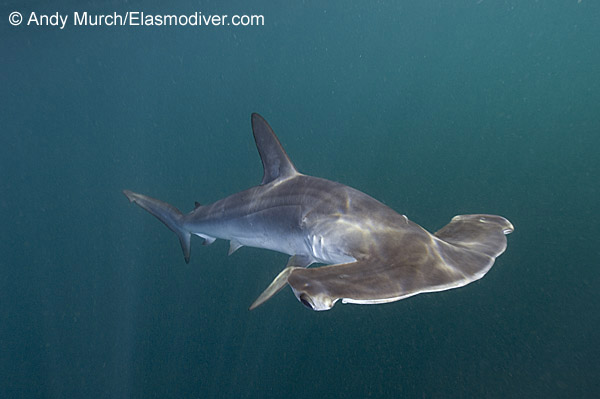| Sphyrnidae (Hammerhead, bonnethead, or scoophead sharks) |
| 500 cm TL (male/unsexed); max.weight: 400 kg; max. reported age: 21 years |
|
pelagic-oceanic; brackish; marine; depth range 0 - 200 m, oceanodromous |
| Widespread in temperate and tropical seas (Ref. 13562). Western Atlantic: Canada to the Virgin Islands; Brazil to Argentina. Eastern Atlantic: British Isles to Côte d'Ivoire, including the Mediterranean. Indo-Pacific: South Africa to Sri Lanka; southern Siberia to Viet Nam (Ref. 13562); southern Australia, New Zealand, and Hawaii (Ref. 13562). Eastern Pacific: northern California, USA to Chile. |
|
Dorsal spines (total): 0-0; Dorsal soft rays (total): 0-0; Anal spines: 0-0; Anal soft rays: 0-0. A large hammerhead without a notch at the center of the curved headhead (Ref. 58085); but with prominent lateral indentations; prenarial grooves well-developed; snout short, 1/5 to less than a third of head width; mouth broadly arched (Ref. 114967); the first dorsal fin is moderately high, te second dorsal and pelvic fins are low. Colour olive-grey or dark grey above, white belowm, and the undersides of the pectoral fin tips dusky (Ref. 58085), |
| Occurs inshore and well offshore (Ref. 5578), over continental and insular shelves (Ref. 244). Coastal, pelagic, and semi-oceanic, but often bottom associated at 1-139 m (Ref. 58302). Migrates northward in summer; young often in large aggregations of hundreds of individuals (Ref. 13562). Prefers to feed on small sharks, skates and stingrays, but also preys on bony fishes, shrimps, crabs, barnacles and cephalopods (Ref. 244). Viviparous (Ref. 50449). Regarded as being dangerous to people, though only few can be tentatively attributed to this species due to its occurrence in temperate waters (Ref. 244). Reported to cause poisoning (Ref. 4690). Caught occasionally by shark and tuna longline fisheries (Ref.58048). Meat utilized fresh, dried-salted, and possibly smoked for human consumption; liver oil for vitamins, fins for soup, hide for leather, and carcasses for fishmeal (Ref. 244). Used in Chinese medicine (Ref. 12166). Become sexually mature when 250 to 300 cm long. The female gives birth to 30 - 40 young (Ref. 35388). |
|
Vulnerable (VU); Date assessed: 08 November 2018 (A2bd) Ref. (130435)
|
| traumatogenic |
|
Source and more info: www.fishbase.org. For personal, classroom, and other internal use only. Not for publication.

